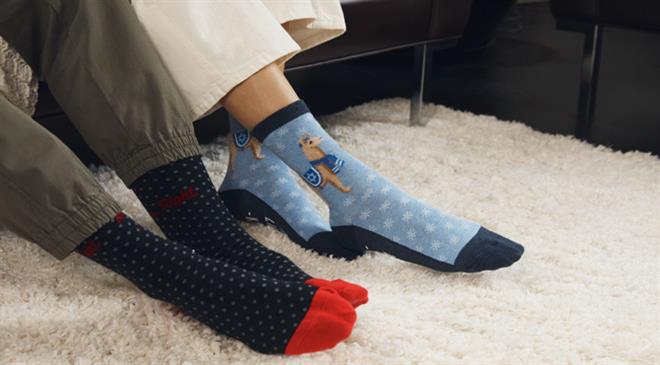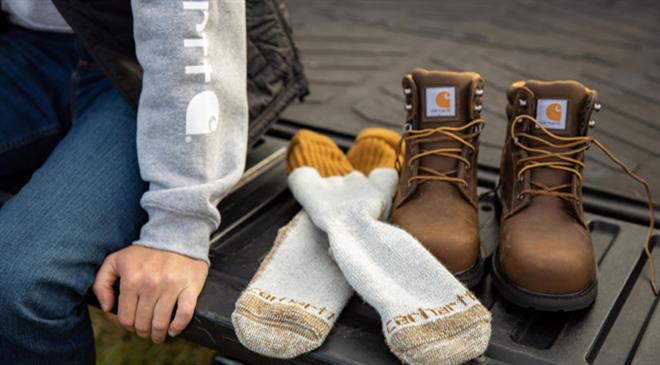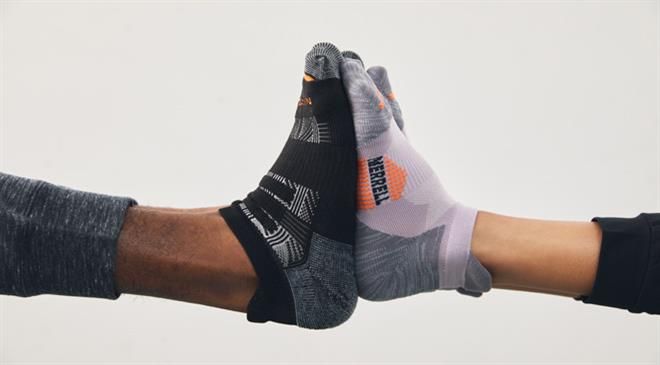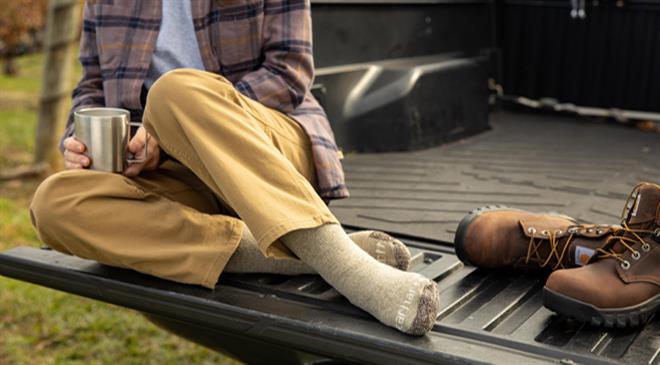Notable trend towards cozy & comfortable
Founded in 1921, US-based Renfro Brands is a leading designer, manufacturer, and marketer of socks and legwear products. Since its inception, the company claims to have pioneered some of the earliest innovations in sock manufacturing, from standardising sock sizes to eliminating toe seams. In a chat with Paulami Chatterjee, Stan Jewell, CEO & president of Renfro Brands, discusses the changes in the sock industry, what makes Renfro a unique sock company in the US, and the launch of its new marketplace - Loops & Wales.
What is the USP of your legwear in terms of design, manufacturing, and packaging? What kind of market surveys do you do for the same?
Through Renfro Brands' portfolio of brands, we have a sock for practically any occasion. While there are hundreds of sock companies in the United States, almost all of them are mono-branded, and most focus on narrow market segments. We are unique in the fact that we have the expertise to design and market socks in the basics/essentials segment, the performance segment, wellness, fashion, and novelty.
How has COVID-19 played out in the sock industry?
The pandemic has impacted every facet of the sock industry by disrupting supply chains, temporarily closing many traditional retailers, and severely impacting the health and financial welfare of our consumer base. On the other hand, socks are a basic necessity worn every day by consumers so there was still demand for socks throughout the pandemic. Consumers shifted their purchasing from traditional retail channels to online or retailers deemed "essential' like Walmart, Costco and Target, among others. Many of our competitors are solely reliant on foreign sources of supply and were unable to fulfill that demand as countries closed their borders to reduce the spread of the virus. Renfro has the largest US sock manufacturing capacity and was able to use that to meet consumers' needs while also keeping American workers employed. In addition, very early in the pandemic, we were also able to utilise our equipment to supply a large volume of cloth face masks when there were not many options available to consumers.
One of the most significant and lasting trends impacting all consumer products is the acceleration of online purchasing. Looking forward, as consumers continue to enjoy the convenience of online purchasing, we believe that brick and mortar retail will recover but likely not to the levels it once was. Renfro continues to invest in the infrastructure to provide consumers the socks they need wherever they shop and our recent launch of Loops & Wales, an online sock marketplace for all occasions, is one example of that effort. In addition to the online trend, we believe that offering products Made in America by American workers will continue to be an important component of our business and an important contribution to the US economy in the communities in which we operate.
How have sales been impacted since COVID-19? What was the growth story in the year before COVID-19 and what is the target set now?
The company has the most diverse product and brand portfolio in the industry with a mix of the 20 globally recognised brands spanning the essentials, fashion, athletics, outdoors, work and wellness categories. Sales of our fashion, athletic and outdoor products were severely impacted during the first few months of the year as the retailers who sell those products largely fell into the "non-essential" business categories and were closed for several months. Sales of our essentials and wellness products significantly outperformed expectations as many consumers who traditionally shopped at "non-essential businesses" shifted their purchasing to essential businesses carrying those products. Lastly, sales of all of our products to online retailers significantly exceeded expectations and we expect that to continue.
Looking forward, we expect that our sales to online retailers and on our own websites will continue to accelerate and that there will be continued recovery of most of our traditional retail base. A lot will depend on the spread of COVID post-holiday and the successful rollout of a vaccine.
What are some of the findings on your ground research about legwear?
At Renfro, we see several takeaways that bubble up from sock sales, social media dialogue, and our research. Unsurprisingly, comfort and casual styles have risen to the top as consumers spend more time at home. In that vein, online sales have jumped which is nicely timed for our launch of Renfro's Loops & Wales marketplace.
We have observed that consumers have a heightened attention to detail which manifests in three ways. First, the product must deliver on its promise. Second, materials and the performance of the product is scrutinised by consumers. And finally, Made in the USA has become an increasingly important selling point and something Renfro highlights since it is the largest sock manufacturer in the United States. Another trend we see is the demand for healthier lifestyle products as people reconcile the impact of environmental factors on their health. For Renfro Brands that means developing more natural, and sustainable products.
Which are your major markets worldwide?
Renfro has a strong market presence in the United States as well as in Canada, Mexico, and Japan. We also have a European presence, with our office in the Netherlands; and we have offices in China as well although these colleagues are primarily focused on supply chain activities.
How has customer preferences changed and what changes does it bring into your business?
Consumer preferences have changed significantly over the past decade. Styling options have greatly proliferated. There is also a lot more technology in socks today relative to ten years ago. So, consumers can really tailor their sock purchases to individual need and preference.
More recently, as a result of the pandemic, there has been a notable trend towards "cozy and comfortable." This is likely a trend that will last as long as work from home is prevalent.
What is the global size of the socks and legging industry?
Various research firms estimate that the world socks and tights/leggings market is a $50 billion industry and they project ~8 per cent expected CAGR for the next 5 years.

What kind of investment have you made into your new Italian-made machines which are used to make socks without toe seams?
Renfro Brands has invested more than $30 million in automatic toe closing and seamless toe knitting equipment.

How is your brand makeover working out? What vision do you have for your marketplace Loops and Wales?
The corporate brand refresh is going extremely well. Press coverage has garnered over 113 million media impressions across secured placements in both national and regional outlets such as Footwear News, Who What Wear, Triad Business Journal and Yahoo! Finance. Internally, our employees have also reacted really well to the new image. They are excited to start using all the visual applications in their work and are inspired about the future and new direction of Renfro Brands.
Our vision for Loops & Wales is to become the #1 destination for socks. Socks are going through a renaissance. We're leveraging our almost 100 years of industry knowledge into an easy, inspiring, and engaging digital shopping experience for people searching for the right socks for every occasion.
Where does Renfro figure in the global sock industry? What is its market share?
We believe Renfro is one of largest sock companies and possibly the largest standalone sock company in the US. It is difficult to determine exact market share but we estimate our share of the US market at roughly 15 per cent.
Who are the people behind establishing Renfro Brands?
Kadian Langlais, vice president of Direct-To-Consumer and Digital, and I partnered with Bruce Mau Design to create a refreshed corporate identity that acknowledges the legacy and innovations of the company's past, while signaling our new ambitions for the future. The new visual identity is an expression of our leadership in the legwear space with a modern perspective. Additionally, Rebecca Aamodt, our creative director, brought the visual identity to life by creating engaging and compelling applications that live in our brand materials and on our website.
What future plans of Renfro?
We will continue build and grow our portfolio of brands and diversify our business. We will disproportionately invest in digital to grow our Direct-to-Consumer business. And we also have targeted growth internationally to capitalise where our brands can resonate with consumer needs.
What are your projected sales for the next two years?
Over the next couple of years, we project that our revenue will experience double digit growth, but this will vary by product category, by brand, and by channel. Some traditional channels, such as department stores, will continue to struggle but will be offset by continued expansion of e-commerce. Our e-com revenue has more than doubled this year, and with continued investment in this area, and with the introduction of Loops & Wales, we expect this trend to continue.
Being in the sock industry for a century, what are the highs and lows the company has witnessed? What was the turning point as such?
During the company's first 60 years Renfro was similar to many other medium-sized sock companies, primarily manufacturing private label socks for retailers like Kmart, Sears and JC Penney. While there were some brands, such as Gold Toe that sold primarily in department stores, the industry was mostly a private label item business. Over this same period, the market experienced significant retail consolidation and many regional retailers were either acquired or went out of business. The consolidation meant fewer retailers controlled a much larger share of the market, increasing the need for larger more sophisticated suppliers like Renfro. In addition, consumers began viewing socks as an important clothing accessory as opposed to a basic commodity. They began seeing that socks could fashionably compliment their outfits, make a personal statement, or contain performance features that could benefit them in their work and lifestyle pursuits.
Understanding these market changes was the key turning point for Renfro. We began to expand our business and expertise through acquisitions and by adding globally recognised brands such as Fruit of the Loom, Ralph Lauren, Dr. Scholl's, Hot Sox, and K. Bell to our portfolio of licensed and owned brands. This market diversity positioned Renfro to adapt and change as market dynamics, consumer preferences and behaviour evolved. Over the last few years, the way consumers shop and what they shop for has continued to change. This evolution has been accelerated by the pandemic and in order to continue to succeed as a brand in the future, we realised that Renfro needed to continue to adapt so these new initiatives and corporate branding are an important part of this growth.

How big is your design team?
Our design team is made up of about 40 team members across essentials, performance and fashion categories.
What percentage of your profits is ploughed back into R&D?
R&D is an important component of what we do and during the last fiscal, we invested between 1per cent and 2 per cent of our total revenue in R&D. Those efforts span a wide variety of activities including developing new product categories, enhancing the features and benefits of existing products, exploring new sustainable raw materials, improving manufacturing processes, and evaluating new technology.
What new innovations are you currently working on?
We approach innovation from a strategic lens that considers technological discoveries, process improvement, consumer trends and footwear industry advancements. Renfro distills these into themes and project categories. One example, we have several sustainability projects underway, some of which include water-efficient dye processes, recycled natural fibres and the investigation of biodegradable yarns. We also experiment with sock construction innovations that provide greater comfort or health to consumers. A few projects in this area include cooling technologies and sportswear design that prevents blisters.
Where is the manufacturing done? Is it done inhouse in a factory or given for job work?
We are the largest manufacturer of socks in the US and approximately 30 per cent of what we sell is manufactured in the US at our facilities in Alabama, Tennessee and North Carolina.

What is your production capacity? How is the demand and supply worked out?
Domestically, we produce more than 3 million pairs of socks per week. A robust sales and operations process drives demand & supply.
Where does sustainability feature in the whole method of your sock production? What percentage of sustainability and circularity does this promise?
Renfro Brands looks at sustainability with a focus on environmental and energy impact. We operate in an environmentally responsible manner-in full compliance with the laws of a country, state or locality for all our fully owned locations. For operations both owned and not owned by Renfro Brands, we have a Quality Assurance programme that inspects partners carefully. Notably, the convergence of sustainable initiatives by brand and retail partners makes for an ongoing effort at Renfro. We work closely with exacting retail and brand partners like Walmart (Project Gigaton) and Ralph Lauren (Global Citizenship).
As part of our sustainability efforts, we joined the Sustainable Apparel Coalition (SAC) and the Sustainable Packaging Coalition (SPC) to help guide us in best practices. We track and continue to innovate materials sourcing, manufacturing processes, logistics/transportation/shipping, product end-use and energy used at facilities. (PC)





